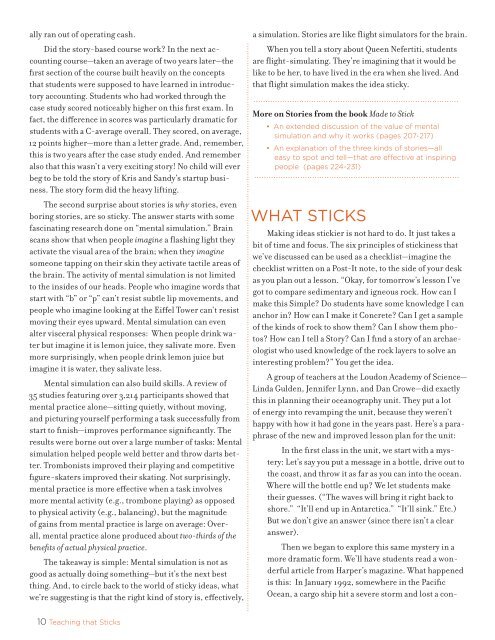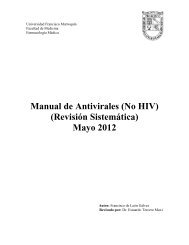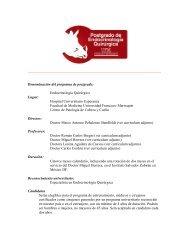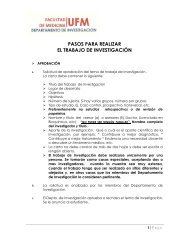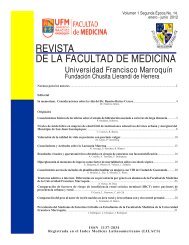Teaching That Sticks (pdf)
Teaching That Sticks (pdf)
Teaching That Sticks (pdf)
- No tags were found...
You also want an ePaper? Increase the reach of your titles
YUMPU automatically turns print PDFs into web optimized ePapers that Google loves.
ally ran out of operating cash.<br />
Did the story-based course work? In the next accounting<br />
course—taken an average of two years later—the<br />
first section of the course built heavily on the concepts<br />
that students were supposed to have learned in introductory<br />
accounting. Students who had worked through the<br />
case study scored noticeably higher on this first exam. In<br />
fact, the difference in scores was particularly dramatic for<br />
students with a C-average overall. They scored, on average,<br />
12 points higher—more than a letter grade. And, remember,<br />
this is two years after the case study ended. And remember<br />
also that this wasn’t a very exciting story! No child will ever<br />
beg to be told the story of Kris and Sandy’s startup business.<br />
The story form did the heavy lifting.<br />
The second surprise about stories is why stories, even<br />
boring stories, are so sticky. The answer starts with some<br />
fascinating research done on “mental simulation.” Brain<br />
scans show that when people imagine a flashing light they<br />
activate the visual area of the brain; when they imagine<br />
someone tapping on their skin they activate tactile areas of<br />
the brain. The activity of mental simulation is not limited<br />
to the insides of our heads. People who imagine words that<br />
start with “b” or “p” can’t resist subtle lip movements, and<br />
people who imagine looking at the Eiffel Tower can’t resist<br />
moving their eyes upward. Mental simulation can even<br />
alter visceral physical responses: When people drink water<br />
but imagine it is lemon juice, they salivate more. Even<br />
more surprisingly, when people drink lemon juice but<br />
imagine it is water, they salivate less.<br />
Mental simulation can also build skills. A review of<br />
35 studies featuring over 3,214 participants showed that<br />
mental practice alone—sitting quietly, without moving,<br />
and picturing yourself performing a task successfully from<br />
start to finish—improves performance significantly. The<br />
results were borne out over a large number of tasks: Mental<br />
simulation helped people weld better and throw darts better.<br />
Trombonists improved their playing and competitive<br />
figure-skaters improved their skating. Not surprisingly,<br />
mental practice is more effective when a task involves<br />
more mental activity (e.g., trombone playing) as opposed<br />
to physical activity (e.g., balancing), but the magnitude<br />
of gains from mental practice is large on average: Overall,<br />
mental practice alone produced about two-thirds of the<br />
benefits of actual physical practice.<br />
The takeaway is simple: Mental simulation is not as<br />
good as actually doing something—but it’s the next best<br />
thing. And, to circle back to the world of sticky ideas, what<br />
we’re suggesting is that the right kind of story is, effectively,<br />
a simulation. Stories are like flight simulators for the brain.<br />
When you tell a story about Queen Nefertiti, students<br />
are flight-simulating. They’re imagining that it would be<br />
like to be her, to have lived in the era when she lived. And<br />
that flight simulation makes the idea sticky.<br />
More on Stories from the book Made to Stick<br />
• An extended discussion of the value of mental<br />
simulation and why it works (pages 207-217)<br />
• An explanation of the three kinds of stories—all<br />
easy to spot and tell—that are effective at inspiring<br />
people (pages 224-231)<br />
WHAT STICKS<br />
Making ideas stickier is not hard to do. It just takes a<br />
bit of time and focus. The six principles of stickiness that<br />
we’ve discussed can be used as a checklist—imagine the<br />
checklist written on a Post-It note, to the side of your desk<br />
as you plan out a lesson. “Okay, for tomorrow’s lesson I’ve<br />
got to compare sedimentary and igneous rock. How can I<br />
make this Simple? Do students have some knowledge I can<br />
anchor in? How can I make it Concrete? Can I get a sample<br />
of the kinds of rock to show them? Can I show them photos?<br />
How can I tell a Story? Can I find a story of an archaeologist<br />
who used knowledge of the rock layers to solve an<br />
interesting problem?” You get the idea.<br />
A group of teachers at the Loudon Academy of Science—<br />
Linda Gulden, Jennifer Lynn, and Dan Crowe—did exactly<br />
this in planning their oceanography unit. They put a lot<br />
of energy into revamping the unit, because they weren’t<br />
happy with how it had gone in the years past. Here’s a paraphrase<br />
of the new and improved lesson plan for the unit:<br />
In the first class in the unit, we start with a mystery:<br />
Let’s say you put a message in a bottle, drive out to<br />
the coast, and throw it as far as you can into the ocean.<br />
Where will the bottle end up? We let students make<br />
their guesses. (“The waves will bring it right back to<br />
shore.” “It’ll end up in Antarctica.” “It’ll sink.” Etc.)<br />
But we don’t give an answer (since there isn’t a clear<br />
answer).<br />
Then we began to explore this same mystery in a<br />
more dramatic form. We’ll have students read a wonderful<br />
article from Harper’s magazine. What happened<br />
is this: In January 1992, somewhere in the Pacific<br />
Ocean, a cargo ship hit a severe storm and lost a con-<br />
10 <strong>Teaching</strong> that <strong>Sticks</strong>


